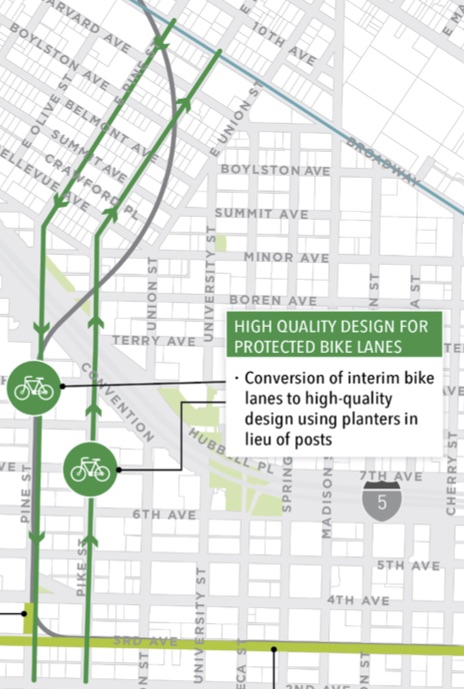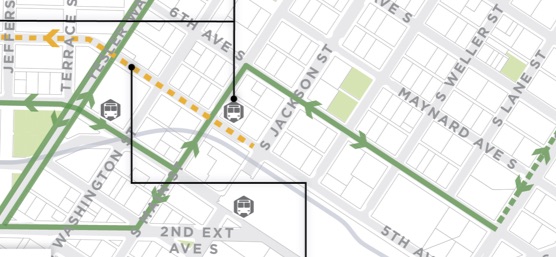New downtown vision includes 4th Ave bike lanes, new transit pathway on 6th Ave

Map presented to the One Center City Advisory Group.
After months of talks, agency leaders have a near-term plan for downtown streets that both builds a two-way protected bike lane on 4th Ave and creates a transit pathway to keep buses moving once they are kicked out of the transit tunnel next year.
The plan as presented to the Once Center City Advisory Group (PDF) would improve transit travel times for buses even after building a new protected bike lane on 4th Ave. This looks like a promising resolution to one of the biggest sticking points in the downtown transportation remake effort. And instead of pitting transit against biking, the new effort looks at how prioritizing both could lead to big increases in downtown street capacity.
When all the planned near-term changes are complete (including complete Pike/Pine bike lanes from 2nd to Broadway, bike lanes on 7th and 8th Avenues, a connection to Dearborn in the south end and the under-construction 2nd Ave bike lane extension in Belltown), analysis predicts a nearly 160 percent increase in daily bike trips downtown by 2023. This includes an estimated 25,000 bike share trips as both bike lane and shared bike networks grow.
 In all, the new bike connections along with new transit service will allow downtown streets to move 10,000 more people per hour of peak travel time, according to the One Center City analysis. And the travel time per person, aggregated across all modes, would improve compared to taking no action:
In all, the new bike connections along with new transit service will allow downtown streets to move 10,000 more people per hour of peak travel time, according to the One Center City analysis. And the travel time per person, aggregated across all modes, would improve compared to taking no action:
It is great that the agencies behind the One Center City partnership (including SDOT, King County Metro, Sound Transit and the Downtown Seattle Association) are looking at how biking and transit can work together instead of pitting them against each other.
After a bold plan to turn 5th Ave into a transit mall was taken off the table due to a combination of business opposition and fears that the plan was too ambitious to be completed in time, there were serious worries that transit service would take a big hit. Then the 4th Ave protected bike lane, a vital piece of the Basic Bike Network, was pitted against a second bus lane on 4th Ave. That was troubling, since Seattle clearly needs both transit and biking.
Questions still remain about how moving northbound bus stops up to 6th Ave affect transfers and the walkshed of bus stops (several of with will now be adjacent to I-5, which is not great). But hopefully the improvements in travel times make up for these changes.
The analysis does not seem to factor walking. We should be sure that any new traffic signal work puts walking travel times and safety at the forefront. Because as the number of jobs grows downtown and in South Lake Union, walking is absorbing an enormous amount of the added transportation load. That's a very good thing, and a trend that will only continue to grow (unless agencies do something really unwise, like increase walk signal wait times like on Mercer Street).
But planners predict that the changes will significantly improve safety for people of all modes, including people walking.

The plan also calls for a quick follow-up to upgrade and extend the "pilot" bike lanes on Pike and Pine. SDOT has already started construction on a key downtown section of those bike lanes. The One Center City plan calls for both an upgraded level of protection and an extension all the way to Broadway.
 The plan also includes a south end connection from both 2nd and 4th Ave bike lanes to Dearborn via Main St and 6th Ave. This is big step forward in that it's the first time a potential path has been identified. 6th Ave is a good route through the ID, and Main St is much better than previous efforts to put the bike route on the much steeper Washington St.
The plan also includes a south end connection from both 2nd and 4th Ave bike lanes to Dearborn via Main St and 6th Ave. This is big step forward in that it's the first time a potential path has been identified. 6th Ave is a good route through the ID, and Main St is much better than previous efforts to put the bike route on the much steeper Washington St.
 But the short connection from 2nd and 4th to the ID is not perfect. The blocks between 4th and 6th Avenues require significant climbs, so the question is whether many people are going to bike up a hill just to come back down when there's a much flatter option right there: Jackson St.
But the short connection from 2nd and 4th to the ID is not perfect. The blocks between 4th and 6th Avenues require significant climbs, so the question is whether many people are going to bike up a hill just to come back down when there's a much flatter option right there: Jackson St.
Ultimately, Jackson St is the only great option for a bike route. No other street is continuous from Pioneer Square to the International District, the Central District and beyond. And no other street plugs into both 2nd and 4th Avenues with relatively little change in grade. The natural flow of biking downtown to the ID is to turn on Jackson, and it's going to take a very good bike route alternative to change that desire.
The best case would be to fund a rebuild of the stretch of Jackson that the First Hill Streetcar screwed up in order to create space for both protected bike lanes and priority for transit.
In lieu of a major Jackson Street rebuild (or a major bus purchasing effort to replace every Jackson-traveling bus with coaches that have doors on both sides so they can serve the streetcar platforms instead of the curb), we're going to need an interim solution that works for people trying to bike this vital missing piece of the downtown bike network.
There's no obvious easy answer. The Main-to-6th option looks great on a flat map, but as you can see in this Google Street View image, 5th Ave goes downhill at Main Street while Main goes up a significant hill to 6th Ave before coming back down into the heart of the ID (the giant retaining wall for the parking lot conveniently shows the grade change):

Also pictured: A ghost bike in memory of a man killed in a collision with a Metro bus in May 2016.
Jackson is the flattest option, but Main St to 5th Ave is the next-flattest option. Once in the ID, 6th Ave is a great option for protected bike lanes (there's already a painted bike lane that could use a major upgrade). The question is whether people will use a connection that takes them all the way up to the 6th/Main intersection just to come back down.
A connection on 2nd Ave Ext to 4th Ave S to Seattle Blvd would also connect to Dearborn. It would be very flat and direct, but it would mostly bypass the ID. And there are also some tricky spots in that option (like navigating the I-90 ramps and the bridge where Seattle Blvd meets 4th Ave S).
It's great that we're finally to the point where we're discussing route options at the south end of downtown. If any readers have any other ideas for how to make this connection, let us know in the comments below.
